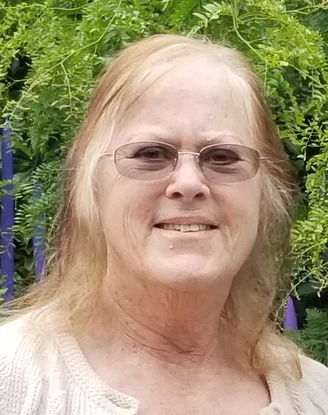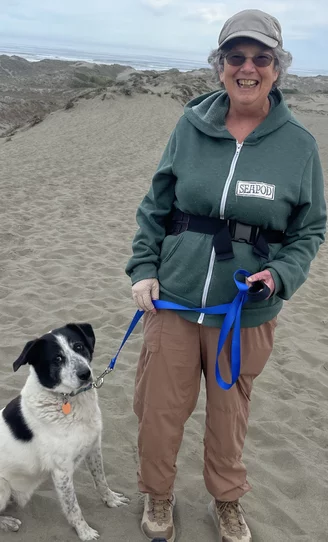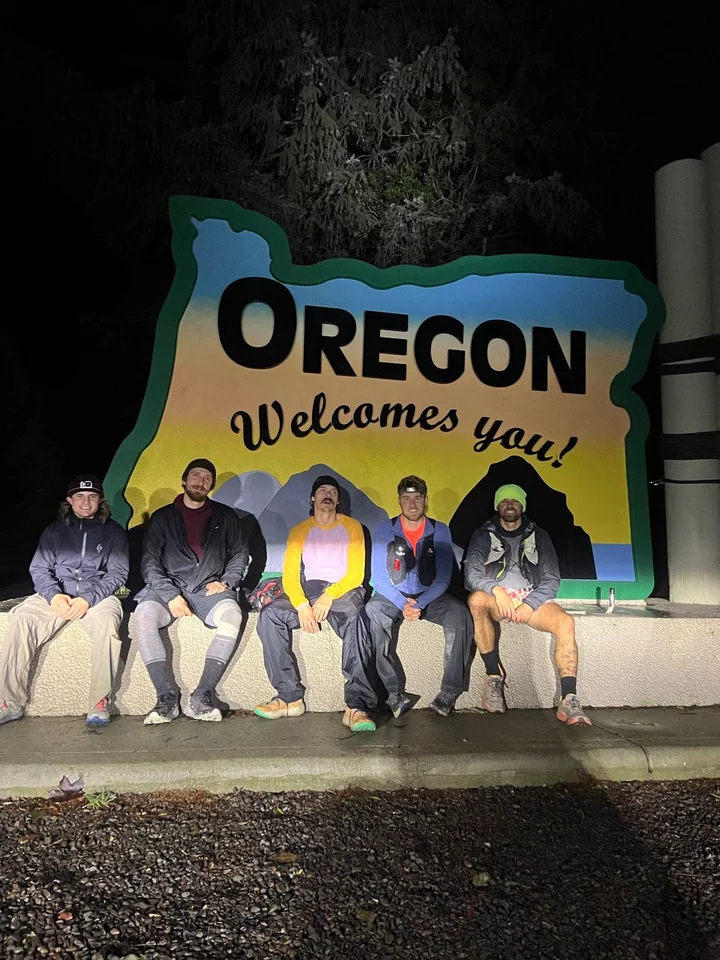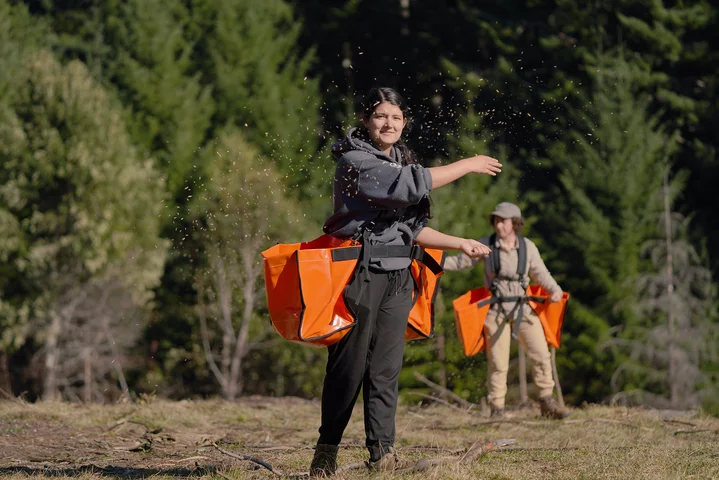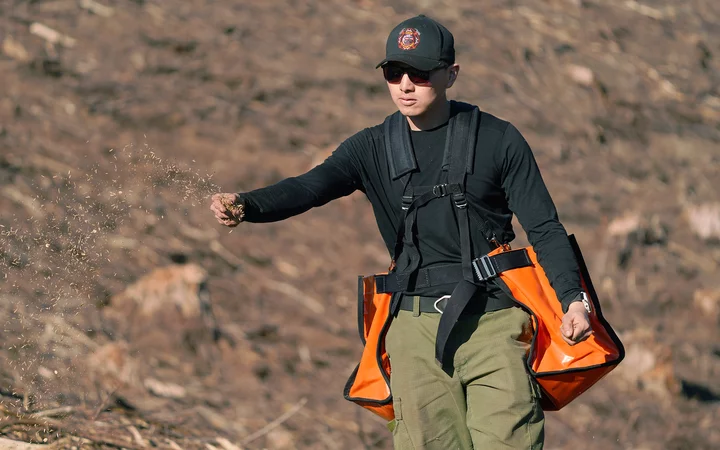OBITUARY: Joyce Ann Harmon, 1949-2025
LoCO Staff / Friday, Jan. 24, 2025 @ 6:56 a.m. / Obits
Joyce Ann Harmon
March 10, 1949 – January 17, 2025
It is with deep sorrow that we announce the passing of Joyce Ann Harmon, of Arcata, who left us on January 17, 2025, at the age of 75. Joyce was born in Eureka on March 10, 1949, to Annie J. Fisher and Vern A. Martin, both of whom preceded her in death. She was raised in Fortuna and lived most of her life in Arcata. Joyce graduated as Valedictorian from Fortuna High School in 1967, later earning a BA in Journalism from Humboldt State University.
On November 22, 1975, Joyce married the love of her life, James E. Harmon, and together they raised two daughters, Ann C. Lunsford (born January 17, 1976) and Jamie M. Boltzen (born July 18, 1978). Joyce’s family was always her greatest joy, and she cherished the time spent with her two granddaughters, Samantha M. Tellez (born January 24, 1994) and Allyson D. Boltzen (born September 7, 2000).
Joyce was passionate about many things in life, including her love for the arts, travel, and spending time outdoors. She loved going to the movies, attending concerts, camping, swimming, dancing, and especially cruising to new places. She also had a deep commitment to her work and her community. Joyce spent 25 years serving as the Secretary at the Mad River Fish Hatchery with the Department of Fish & Wildlife, a position where she became well-known and respected. Prior to that, she worked at Napa State Hospital, Caltrans, and later dedicated her time to In-Home Support Services, where she cared for the elderly and disabled.
A long-standing member of the Arcata United Methodist Church, Joyce served in many capacities over the years, including teaching Sunday School, keeping attendance records, and hosting Coffee Hour. She was also the church secretary for many years, where she made countless contributions to the congregation and its mission.
Joyce is survived by her husband, James E. Harmon, daughters Ann C. Lunsford, her husband, Addison J Lunsford, and Jamie M. Boltzen, granddaughters Samantha M. Tellez, her husband Elijah B Tellez and Allyson D. Boltzen, also Joyce’s brother, James A. Martin. She will be deeply missed by her family, friends, and the many lives she touched over the years.
A viewing will be held on January 31, 2025, from 4 p.m. to 7 p.m. at Paul’s Chapel in Arcata. A memorial service will be held at 11 a.m. on February 1, 2025, at Greenwood Cemetery in Arcata.
###
The obituary above was submitted on behalf of Joyce Harmon’s loved ones. The Lost Coast Outpost runs obituaries of Humboldt County residents at no charge. See guidelines here. Email news@lostcoastoutpost.com.
BOOKED
Today: 4 felonies, 8 misdemeanors, 0 infractions
JUDGED
Humboldt County Superior Court Calendar: Today
CHP REPORTS
No current incidents
ELSEWHERE
County of Humboldt Meetings: Behavioral Health Board Executive Committee Meeting - Nov. 5, 2025
Governor’s Office: One year after Los Angeles firestorms, California continues statewide recovery and behavioral health support
Fishing the North Coast : Dry Stretch Sets the Stage for Prime Steelhead Conditions
Governor’s Office: Governor Newsom delivers final State of the State Address, honoring California’s past and reaffirming a brighter future for all
OBITUARY: Sharon Levy, 1959-2024
LoCO Staff / Friday, Jan. 24, 2025 @ 6:56 a.m. / Obits
Sharon Levy died
on December 30, 2024 at St. Joseph’s Hospital in Eureka at age 65.
She was born in Chicago, Illinois. There she attended Metro High
School – an experimental “school without walls” which attracted
diverse public high school students from every corner of the city.
She attended Oberlin College, then University of Illinois, graduating
with a degree in biology. Heading west, she attended Oregon State
University, where in 1988 she completed a Master of Science degree in toxicology.
In the summer of 1988, she went to work as a seasonal wildlife biologist in the Hayfork district of the Shasta-Trinity National Forest. There Sharon met Hugh Scanlon, who was working as a seasonal forestry technician for the US Forest Service. At the end of the season, Sharon returned to Oregon State as a laboratory technician and Hugh followed. Then Sharon followed Hugh to Fort Bragg when he accepted a permanent position working for CALFIRE.
While in Fort Bragg, Sharon worked as a field biologist for several consulting firms, including Buckberg & Associates, Mad River Biologists, and CH2M Hill. Her primary work was conducting field surveys of spotted owls, but also included wetlands restoration research. Sharon also began to write science-focused articles for magazines as a freelance writer. One of her first publications was an article about the Arcata Marsh, for the United Airlines in-flight magazine Hemispheres.
In Spring 1991, Sharon Levy and Hugh Scanlon were married on the Mendocino headlands. They were married for 33 years. In 1994, Hugh’s employment brought him to the CALFIRE Fortuna office. Sharon and Hugh moved to Arcata. She quickly found roles as a wildlife biologist, working for Dave Nielsen on the staff of Pacific Northwest Biological for several years. Sharon also continued publishing as a science writer.
In 1999, Sharon was diagnosed with non-Hodgkins lymphoma. She had a long, hard battle with the disease, but was cancer-free by 2001. She decided to step away from the rigors of field biology and focus on her passion for writing. She became quite accomplished, writing for many publications including Audubon, Bioscience, High Country News, Undark, OnEarth, and Knowable magazines. Topics included: native bees, bird conservation in Hawai’i, the reintroduction of condors in the Bald Hills, and the aboriginal use of fire in the Australian outback. Several of her articles can be found at her website, SharonLevy.net.
In 2004, Sharon became a mother. She and Hugh adopted Maya Scanlon, who was then ten months old and living in an orphanage near Chongqing, China. Sharon was a good mom and was dedicated to Maya. The family has many friends in the Humboldt adoption community. In 2014, the family took a trip back to China with other families that had ties to the same orphanage.
Sharon’s two books were published through Oxford University Press. Her first book “Once and Future Giants” looked at the extinction of megafauna in several area around the world, and potential lessons for future megafauna restoration. She also wrote “The Marsh Builders” which explored the importance of wetlands, and detailed the unique history of the Arcata Marsh and the area’s wastewater treatment.
Sharon was a musician. She loved to sing and play banjo. Sharon was also a quilter. She was an avid bird watcher. She loved to hike and enjoyed backpacking. She would go rowing in a single racing scull as a member of the Humboldt Bay Rowing Association. She would paddleboard at Big Lagoon. And she loved walking her dog Amos, often for 3-5 miles a day.
Sharon was active in the volunteer community. She led walks at the Arcata Marsh for Friends of the Marsh, and at the Samoa dunes for Friends of the Dunes. She also volunteered to walk dogs at the Humboldt County Animal Shelter.
Sharon is survived by her husband, Hugh Scanlon, daughter Maya Scanlon, brother David Levy (Carolina Chia), nephew Ethan, and cousin Elisa Callow. She was preceded in death by her sister Paula Levy, and parents Sol and Florence Levy of Chicago.
A celebration of life for Sharon Levy will be held on February 15, 2025, 2 p.m. at the Unitarian Universalist Fellowship, 24 Fellowship Way, Bayside. Acquaintances, friends and family are welcome to join us.
###
The obituary above was submitted on behalf of Sharon Levy’s loved ones. The Lost Coast Outpost runs obituaries of Humboldt County residents at no charge. See guidelines here. Email news@lostcoastoutpost.com.
These Guys Ran All The Way From Arcata to Oregon
Dezmond Remington / Thursday, Jan. 23, 2025 @ 3:04 p.m. / Culture , LoCO Sports!
At the Oregon border. Photo courtesy of Thomas Nolan.
Night on the Newton B. Drury Parkway brings out the creatures. Giant salamanders slink across the road, quiet moist feet creeping along the asphalt. No birds except the owls cry out. Flashlights bounce off of glowing eyes in the brush. For one night back in November, six men were alone on that road, 40 miles deep into a run over 100 miles long. For some of them, that was the best part of the trip; for others, the worst; one man thought it was fun, but didn’t feel he hallucinated enough.
The six runners gathered and left at 7 a.m. on Friday, Nov. 22 and the trip was not over for 37 hours, 48 minutes, and 44 seconds, give or take. It is 107 miles from the Arcata Plaza to the Oregon border via Highway 101. 22 of those hours were spent running. Excluding time spent resting and the seven hours they slept, they spent 12 minutes and 20 seconds running every mile.
Those are the statistics that tell part of the story, but the runners tell the whole thing through a long series of anecdotes that range from the disgusting to the sublime. On a group run through the Arcata marsh, they shared many of them.
###
“You have to ask about Colby’s feet,” West Wood said. “And the cat. Ask about the cat.”
Wood, 22, is a surfer and an ultrarunner, but classifying him by the way he spends his time is reductive. Wood’s the man who was saddened by the lack of hallucinations while running Newton B. Drury. On other ultramarathons, he’s seen dead cats stalking him, but it’s not a thing that bothers him.
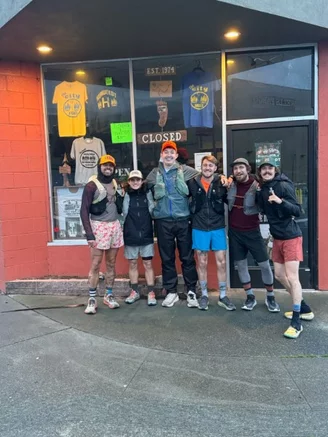
The runners at the start. From left to right: Thomas Nolan, Colby Calabrese, Damian Morton, Austin Nolan, Max Miller, and West Wood. Photo courtesy of Thomas Nolan.
“They’re a bit gnarly,” Wood said, “but they let you know you’re working hard!”
A fierce advocate of colorful clothing and toe socks (“They were a game changer for me!”), Wood helps run the Raccoon Running Club along with Thomas Nolan, 31. The RRC is where most of the group met each other. Founded by Wood and Nolan in 2023, about 20 people meet every Monday night to crank out a couple headlamp-illuminated forest miles. It’s a space that attracts the kind of people who believe spending an entire weekend running to a different state is worth the time.
Nolan was among the six who ran up to Oregon, though it wasn’t his first time doing something similar. In 2023, he and Wood ran on as many trails as possible from McKinleyville to Crescent City, running dozens of miles through old-growth redwoods and up beaches. The November voyage was pretty much all on Highway 101, except for brief forays through Newton B. Drury and Patrick’s Point.
Nolan has run several 200 mile races, a few “backyard” ultras (essentially a winner-takes-all, run-’til-you-drop race), and too many other mind-boggling feats of endurance to list without getting boring, but his affair with running started fairly recently. At a bar for his 25th birthday, he told some friends he was going to run 25 miles to celebrate.
“The next day, I woke up and I was like, ‘Well, I guess I have to do it now!’” Nolan said, laughing. “It just about killed me.”
The recovery took a few weeks, but when he felt back to normal, Nolan decided he had to try running 30 miles. He did that, and 30 miles became 50, and 50 became 100. He got into Strava, a social media site tailored to endurance athletes, and founded the Raccoon Run Club. It’s a lifestyle for him, and when he saw an Instagram post from a friend with the idea to run the whole way to Oregon, he knew he wanted in.
The idea came from Peter Ciotti, another Humboldt-based ultrarunner. Ciotti and Nolan have done some wild things together — one morning they ran 175 laps around the Arcata Plaza — but 100 miles requires a different type of strength. Ciotti wound up with a knee injury and instead brought the runners food and supplies, but his plan had some legs to it. Along with Wood and Nolan, Nolan’s brother Austin decided he’d join, as did three other people who had never run even close to 100 miles.
Before he decided he’d join, Colby Calabrese had never run more than 31 miles in a single go, but when he heard the plan he knew he couldn’t pass the opportunity up. It was Calabrese’s last semester at Cal Poly Humboldt before he left to do Peace Corps work in Peru, and running was how he connected with Humboldt.
“I heard this idea, and I was like, ‘Well, I think I would regret it if I didn’t do it,’” Calabrese said. “I had told them I would do a 100-miler maybe about five years after my first ultra. That turned into just a few months.”
Calabrese’s inexperience hobbled him. He brought enough chocolate chips and turkey to blow out a strap on his backpack before they even hit Trinidad, but only brought a couple pairs of socks for the two-day run. By the time they shuffled into Smith River, Calabrese was ready to drop and had a case of low-grade trenchfoot. Thomas Nolan promised him a foot massage, and that was enough to get him there. When Calabrese peeled his socks off after 90 miles of running, his feet were covered in blisters and had what Nolan called “deep canyons” in the skin of his feet. Crew member Damian Morton (who ran with them until they got to Crescent City) pulled up behind them and gave them a pair of crabber’s gloves. Nolan made good on his IOU. That massage, and a random stray cat that hung out with them, got Calabrese to the end. It was another two weeks before his feet were completely healed.
The supplies Morton and the other members of the crew brought were indispensable, as were the morale boosts. One drop-off stands out in everyone’s minds: steaming bowls of chicken noodle soup delivered to the runners underneath an awning in Orick, protected from the November rain. They’d hardly eaten anything except snacks all day, and eating the soup was nothing short of a religious experience. It was liquid euphoria for the starved athletes, and gave them the energy to push through Prairie Creek and up to Klamath to rest for a few hours.
Starting the next day was hell. It rained most of that day, and they were forced to run through some heavy downpours. There were moments of levity in the pain; Wood found a Tesla wheel in the ditch, popped the logo off, and turned it into a necklace. The group stopped and huddled for cover in a bathroom when the clouds started dumping. The view over Crescent City from a vista point was gorgeous.
There are few types of exhaustion more total than the aches and pains ultrarunning blesses faithful adherents with. Summiting a speed bump turns into a climb that requires a Sherpa. Downhills are just as evil when legs feel like broken 2x4s. Every step is calculated, because a poorly placed foot supporting a body with no strength means an unscheduled meeting with the concrete — and then you have to rise and keep chugging.
The last few miles were torturous. Everyone was exhausted. It was dark and foggy and painful and something had to be done. A few of them pulled their shorts down and ran in the moonlight, one could say, and in that fashion they reached the stone and wood monument that marks a different state. “Oregon welcomes you!,” it reads, and for most travellers all that means is the gas is a bit cheaper and you don’t have to get out of your car to pump it, but for the five that made it all the way it meant THE END.
All were exhausted and ecstatic. They stopped long enough to take a few photos, hopped in the car, and came back to Humboldt.
None of them would change too much if they did it again. Calabrese wants to bring more socks and fewer chocolate chips; Wood needs to run through the whole night, damn the sleep deprivation; and Morton thinks a bigger group would be even more fun.
They all had fun pushing their personal limits and finding out what their bodies could do, they all loved trawling through dark roads crawling with the North Coast’s finest fauna, they enjoyed the scenery and the ocean’s constant pulsing, but there is no subtle way to disguise the sappy revelation that the best part was simply hanging out with a bunch of friends for a while.
“The people were the real tickets,” Thomas Nolan said, his footsteps on marsh gravel easy and silent. “Seeing Damian run so far, and watching Colby and Max finish — those were the highlights. Nothing compares to that.”
Cal Poly Humboldt Announces ‘Direct Admissions’ Program For Eureka Students
LoCO Staff / Thursday, Jan. 23, 2025 @ 2:51 p.m. / Education
A prospective student receiving a certificate of admission to Cal Poly Humboldt during Fall Preview 2024. Photo: Cal Poly Humboldt.
Press release from Cal Poly Humboldt:
Cal Poly Humboldt and Eureka City Unified School District (ECS) have created a partnership to simplify the college admissions process for local high school students. The partnership, centered around a new direct admissions program, will provide students with streamlined access to Cal Poly Humboldt and support their journey to higher education.
“The Direct Admissions program marks a pivotal advancement in the University’s dedication to making higher education that’s accessible for all. We are thrilled to extend this opportunity to more California students eager to embark on a polytechnic education. In partnership with Eureka City Schools, we are forging a pathway for students to achieve their academic aspirations and flourish at Cal Poly Humboldt,” says Chrissy Holliday, Vice President of Enrollment Management and Student Success. “When admissions programs like these are layered with affordability efforts like the Green and Gold Initiative we recently announced, local students should never have to wonder whether a college education is within their grasp.”
ECS high school seniors who are on track to finish A-G coursework with at least a 2.5 GPA, or meet the California State University (CSU) standards for admissions, or who also meet the University’s current admission requirements, may qualify for direct admission to Cal Poly Humboldt. This means students will know in advance of an application that they will earn admission, reducing uncertainty about their path to college. The Direct Admissions program removes common barriers to college admissions by ensuring ECS students are prepared and eligible to enroll at Cal Poly Humboldt upon graduation. Key elements of the partnership include:
Comprehensive support: ECS students will receive clear guidance on admissions requirements, application processes, and relevant programs.
On-campus opportunities: Cal Poly Humboldt will host annual events to familiarize ECS students and families with university life and academic programs.
Tailored presentations: Cal Poly Humboldt admissions counselors will visit ECS schools four times each academic year to engage directly with students and parents.
Application fee assistance: ECS students may receive fee waivers to ensure affordability when submitting their applications.
“This partnership with Cal Poly Humboldt represents a transformative step in ensuring local students have seamless access to higher education. By removing barriers and providing personalized support, we are empowering students to envision and achieve a brighter future,” says ECS Superintendent Gary Storts.
ECS has also integrated with the California College Guidance Initiative, a statewide system for tracking student progress. This will ensure that students receive the support they need to stay on track for college and apply to Cal Poly Humboldt. It will also allow the institution to communicate more easily with qualified students and their families before admission. This collaboration marks a shared commitment to fostering educational opportunities for local students. Both institutions will work closely to ensure the program’s success and adapt to the needs of the community. Through efforts of the Redwood Coast K-16 Educational Collaborative, housed at Cal Poly Humboldt, Executive Director Angela Shull has facilitated communication between the institution and regional high schools.
The Collaborative’s mission of nurturing a college-going culture is deeply rooted in the region’s local high school students’ success at Cal Poly Humboldt. In the future, Cal Poly Humboldt will collaborate closely with other districts in the area to develop similar direct admissions programs for their students.
For more information about Cal Poly Humboldt admissions, visit admissions.humboldt.edu or contact the Admissions office by calling (866) 850-9556 or (707) 826-4402 or emailing apply@humboldt.edu. Learn more about the Green & Gold Guarantee by visiting humboldt.edu/guarantee.
Underpass Update! Caltrans Issues Video Update/Explainer on Those Big Pillars They’ve Built Near Indianola
LoCO Staff / Thursday, Jan. 23, 2025 @ 12:57 p.m. / Infrastructure
PREVIOUSLY:
What’s going on with the Indianola underpass project, you ask? You’ve seen those big structures they’ve built in the safety corridor, and now you wonder what they’re up to next?
Let Caltrans project manager Jeff Pimentel fill you in via the informative video update posted above.
The Yurok Tribe is Restoring Prairie Lands in its Ancestral Territory, and Here are the Hows and the Whys
LoCO Staff / Thursday, Jan. 23, 2025 @ 12:26 p.m. / Environment
Kayla Salinas from the Yurok Wildlife Department hand sows native plant seed on Steven’s Prairie. Photos: Yurok Tribe.
Press release from the Yurok Tribe:
This week, the Yurok Tribe started implementing a critical phase of an ongoing project to restore more than 60 acres of prairie habitat that once blanketed a ridge above Blue Creek.
Staff from three of the Tribe’s natural resources departments are hand-sowing 900 pounds of native plant seed over Steven’s Prairie as part of an integrated effort to reestablish the grassland ecosystem and renew two-miles of salmon and steelhead habitat in Blue Creek, the most productive Klamath River tributary on the Yurok Reservation.
“Our goal is to restore the meadows and prairies to increase plant diversity and abundance that will provide habitat and food for wildlife from insects to elk. Furthermore, many of the prairie plants are used by Yurok people for food, medicine, and utilitarian purposes. Where our wildlife thrives, we thrive, as members of the same ecological community,” says Tiana Williams-Claussen, the Yurok Wildlife Department Director.
A multidisciplinary team of experts from the Yurok Tribe’s Fisheries, Wildlife, Watershed Restoration & Roads, Environmental, Cultural, Forestry and Fire Departments are collaborating on the pivotal Steven’s Prairie Project. Prior to the project, nearly all of the historic prairie was covered in young Douglas firs, which were removed and incorporated into the restoration effort on Blue Creek.
“The whole trees will create excellent habitat for juvenile salmon and steelhead,” explains Sarah Beesley, a Senior Fisheries Biologist for the Yurok Fisheries Department’s Lower Klamath Program.
Steven’s Prairie on the map.
Steven’s Prairie
Since European contact, the Yurok Tribe has lost 99 percent of all prairies on the reservation and adjacent lands, due to industrial timber operations, overly aggressive fire suppression and acentury-long prohibition on traditional burning. Most fish and wildlife populations declined precipitously during the same time period.
The Steven’s Prairie project is the Tribe’s first grassland restoration initiative. The project broke ground this summer when Yurok Watershed Restoration & Roads Department heavy equipment operators uprooted Douglas firs and transported around 400 whole trees with intact root wads down to Blue Creek. The Fisheries Department has already placed some of the trees in strategic locations within the lower two miles of the stream to improve ecological function and enhance fish spawning and rearing habitat.
Over the last three weeks, the Yurok Fire, Environmental, Wildlife, Watershed & Roads departments burned the leftover woody debris and the small remnant of the original prairie.
“These are lands our ancestors burned hundreds of years ago,” says Yurok Fire Department Division Chief Blaine McKinnon. “I would love to come back out here one day to hunt with my son and be able to say I had a part in restoring that prairie to bring back elk and bring back deer to this area.”
The light layer of ash will further enrich the already fertile prairie soil, a perfect planting medium for the 20 different plant species selected for the Steven’s Prairie project. The plant species include deep-rooted bunch grasses, forbs and flowering herbs, such as blue wild rye (Elymus glaucus), herhhlkerh or Indian Potato (Brodiaea laxa) and showy milkweed (Asclepias speciosa). These plants perform many different functions like fixing nitrogen in the soil to support plant growth, providing food for wildlife, and attracting pollinators, including the Mardon skipper, listed as endangered under the California Endangered Species Act, and the monarch butterfly which is currently under review for federal listing as threatened.
Historically, the Tribe used cultural burning to maintain Stevens Prairie, where tribal people hunted grouse, deer and elk. It was also a gathering place for edible and medicinal plants. Prairies support a vast array of plant species and offer large quantities of forage for wildlife, including deer, elk, and the California condor, not to mention small mammals, songbirds and amphibians. Prairies also provide an ideal setting for eagles and hawks to hunt prey.
“In the 25-plus years that I’ve been involved in watershed restoration, this project is the most satisfying. We are creating habitat that will benefit all native wildlife and our community for many generations to come,” says Yurok Watershed & Roads Department Director Richard Nelson.
The Steven’s Prairie project site is temporarily gated to give plants and animals time to repopulate the area. Next year, the Tribe plans to heal many more acres of prairie habitat. Once the projects are complete, the restored prairies are expected to help rebuild deer and elk herds on the reservation and adjacent Yurok managed lands. The restoration of the prairies will also allow more water to enter Blue Creek.
To evaluate the project’s effectiveness, Yurok Tribe Environmental Department Manager Joe Hostler is collecting data throughout the prairie restoration process, while occupying a leadership role within the design and implementation teams. The data will also inform future prairie renewal initiatives. Hostler interviewed the tribal elders who proposed the Steven’s Prairie project years prior.
The Steven’s Prairie restoration project is the first step in returning the prairies that laced the ridgelines of Yurok Territory since time immemorial.
Yurok Firefighter Nah-tes Jackson helps restore Steven’s Prairie.
Centro del Pueblo Announces Hotline, Observer Training in Advance of Potential ICE Raids
LoCO Staff / Thursday, Jan. 23, 2025 @ 11:01 a.m. / Activism
‘From Centro del Pueblo:
Stand with Centro del Pueblo to ensure the safety and rights of all individuals, regardless of their immigration status.
Our ICE-Watch- Migra-Watch is part of the Rapid Response Network of CDP for the empowerment of community members to observe and provide vital information and support during potential immigration enforcement activities in Humboldt.
Goals:
- Protect our community: Monitor and report ICE activity to ensure accountability
- Support those in need: Provide critical information and assistance to families affected
- Build trust and solidarity: Foster a united community ready to respond collectively
- Document ICE activity: Use your phone or notebook to record interactions while maintaining a safe distance.
- Verify information: Ensure that reports of ICE presence are accurate to prevent rumors and unnecessary panic.
- Know Your Rights: Inform community members about their rights and connect them with resources.
Observers do not intervene in enforcement activities but play a key role in documenting and reporting.
CdPueblo announces our hotline to report ICE activity in our community
How to Get Involved
- Sign Up for Training: Join a virtual workshop to learn strategies for defending our community from threats posed by ICE, police, and anti-immigrant groups, as well as rapid response tactics. January 28th at 4pm Registration: bit.ly/taller-lineas-de-
- Stay Connected: Join our social media channels @centrodelpueblo
- Volunteer: Join us at the Sanctuary Garden, Saturday from 10:00 AM to 12:00 PM at the corner of 11th and F St., Arcata.
- Be an advocate, put the word out!

